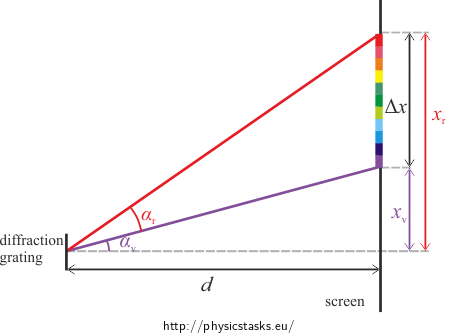Calculation of the Spectrum Width
Task number: 2213
A diffraction grating with spacing of 0.01 mm is perpendicularly illuminated with white light of wavelengths between 390 and 790 nm. What is the width of the continuous first order spectrum created on a projection screen which is 3 m behind the grating?
A picture of the situation

We denoted: d the distance between the diffraction grating and the screen, x v the distance between the first and zero order violet maxima , αv the angle of the first order violet maximum, xr the distance between the first and zero order red maxima, αr is the angle of the first order red maximum and Δx the width of the spectrum on the screen in the picture.
Hint 1
Try to find an equation for angles αv and αr using the optical path difference Δl and a groove spacing b.
Hint 2
Use the image above to express the spectrum width Δx using the distances xv, xr and angles αf, αč.
Notation
b = 0,01 mm =10−5 m groove spacing d = 3 m distance between the diffraction grating and the projection screen k = 1 order of the maximum λv = 390 nm = 3,9·10−7 m wavelength of the violet light λr = 790 nm = 7,9·10−7 m wavelength of the red light Δx = ? (cm) spectrum width Solution

We denoted: d the distance between the diffraction grating and the screen, x v the distance between the first and zero order violet maxima , αv the angle of the first order violet maximum, xr the distance between the first and zero order red maxima, αr is the angle of the first order red maximum and Δx the width of the spectrum on the screen in the picture.
To calculate the spectrum width on the screen Δx we express it using the distances xv, xr and angles αv, αr.
\[\mathrm{Δ}x=\, x_\mathrm{r} − x_\mathrm{v}=\, d\,\mathrm{tg}\,\,α_\mathrm{r} − d\,\mathrm{tg}\,\,α_\mathrm{v}=\,d\left(\mathrm{tg}\,\,α_\mathrm{r} − \mathrm{tg}\,\,α_\mathrm{v}\right).\]We don’t know the angles of the maxima αč and αf in this equation. It holds for those angles:
\[\sin\,α_\mathrm{r} = \, \frac{\mathrm{Δ}l_\mathrm{r}}{b} \quad \mathrm{a} \quad \sin\,α_\mathrm{v} = \, \frac{\mathrm{Δ}l_\mathrm{v}}{b}.\]We substitute the relation with the interference maxima for Δl and set k = 1. Substituting the wavelengths of red and violet light into the expressions we obtain:
\[\sin\,α_r = \, \frac{λ_\mathrm{r}}{b} \quad \mathrm{a} \quad \sin\,α_v = \, \frac{λ_\mathrm{v}}{b}.\]We express the angles αr a αv:
\[α_r = \,\arcsin\, \frac{λ_\mathrm{r}}{b} \quad \mathrm{a} \quad α_v = \,\arcsin\, \frac{λ_\mathrm{v}}{b}.\]We substitute it into the equation for Δx:
\[\mathrm{Δ}x=\,\,d\left(\mathrm{tg}\,\,α_\mathrm{r} − \mathrm{tg}\,\,α_\mathrm{v}\right)=\, d\left(\mathrm{tg}\,\,\arcsin\, \frac{λ_\mathrm{r}}{b} − \mathrm{tg}\,\,\arcsin\, \frac{λ_\mathrm{v}}{b}\right)=\] \[=\, 3(\mathrm{tg}\,\,\arcsin\, \frac{7{,}9{\cdot}10^{−7}}{10^{−5}} − \mathrm{tg}\,\,\arcsin\, \frac{3{,}9{\cdot}10^{−7}}{10^{−5}})\,\dot{=}\,0{,}12\,\mathrm{m} = 12\,\mathrm{cm}.\]Answer
The width of the continuous first order spectrum created on a projection screen which is 3 m behind the grating is 12 cm.
Comment
Thinking about magnitudes of the angles of the first order red or violet maxima we find out that those angles are very small. It holds for such angles:
\[\sin\,\alpha\ \dot{=}\ \, \alpha\ \dot{=}\ \mathrm{tg}\,\,\alpha,\]where the middle equality holds for angles in radians. We will do the calculation once again with the above approximation.
Let us express the angles and values of sin α and tg α to see that this approximation is sufficiently precise:
\[\sin\,\alpha_\mathrm{r} =\, \frac{\lambda_\mathrm{r}}{b}= \,\frac{7{,}9{\cdot}10^{−7}}{10^\mathrm{−5}}=\,0{,}0790, \] \[\alpha_\mathrm{r}\dot=\,0{,}0791 \qquad \Rightarrow\qquad \mathrm{tg}\,\,\alpha_\mathrm{r}\ \dot{=}\ 0{,}0792,\] \[\sin\,\alpha_\mathrm{v} =\, \frac{\lambda_\mathrm{v}}{b}= \,\frac{3{,}9{\cdot}10^{−7}}{10^\mathrm{−5}}=\,0{,}0390,\] \[\alpha_\mathrm{r}\dot=\,0{,}03901 \qquad \Rightarrow\qquad\mathrm{tg}\,\,\alpha_\mathrm{v}\ \dot{=}\ \,0{,}03902,\]We get relations for angles of maxima αr a αv from the picture:
\[\frac{x_\mathrm{r}}{d}=\,\mathrm{tg}\,\,\alpha_\mathrm{r}\ \dot{=}\ \,\alpha_\mathrm{r}\ \dot{=}\ \,\sin\,\alpha_\mathrm{r} = \frac{\mathrm{\Delta}l_\mathrm{r}}{b},\] \[\frac{x_\mathrm{v}}{d}=\,\mathrm{tg}\,\,\alpha_\mathrm{v}\ \dot{=}\ \,\alpha_\mathrm{v}\ \dot{=}\ \,\sin\,\alpha_\mathrm{v} = \frac{\mathrm{\Delta}l_\mathrm{v}}{b},\]We can substitute the equation for interference maxima Δl = kλ for Δl, set k = 1 and express xr and xv:
\[\mathrm{\Delta}x=\, x_\mathrm{r} − x_\mathrm{v}=\,\frac{d}{b}\left(\lambda_\mathrm{r} − \lambda_\mathrm{v}\right)\]Substituting the values from the assignment:
\[\mathrm{\Delta}x=\,\frac{3}{10^\mathrm{−5}}\cdot\left(7{,}9{\cdot}10^{−7} − 3{,}9{\cdot}10^{−7}\right)\,\mathrm{m}= \,0{,}12\,\mathrm{m}=\,12\,\mathrm{cm}.\]We see that the solution is the same, although we applied the approximation on the angles.


